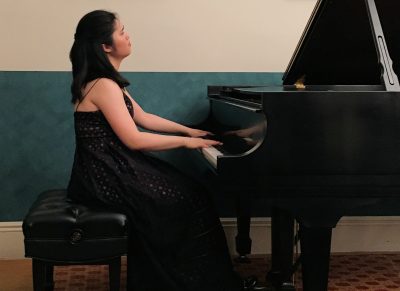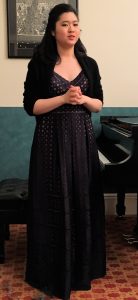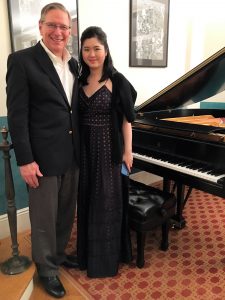On Saturday evening of February 23rd 2019, I was privileged to attend pianist Jocelyn Lai‘s recital at Robin Shoemaker’s residence on Central Park West. The program was an interesting mix anchored by one of Schubert’s last piano sonatas.
Haydn: Sonata No. 55 in B flat Major, Hob XVI 41
In Haydn’s time, Ms. Lai noted, the Sonata would normally be a salon performance. Indeed the tight acoustics of Robin’s salon suited Haydn’s chirpy 1784 work. His twirls twinkled like confetti from Ms. Lai’s fingers, making for a delightful start to our evening.
Jacques Hétu (1938-2010): Variations pour piano, Op. 8
If Haydn was an icebreaker, Hétu’s dissonance-driven work was more like shattered icicles. As Ms. Lai explained, Hétu explores the complete range of expression of the modern piano in just 9 minutes.
Although Hétu was somewhat opaque to me, I take comfort from the fact that a musician of Ms. Lai’s caliber values it. It is a credit to her interpretation that the rest of us could find moments to appreciate in this eclectic work.
Ravel: La Valse (arr. for solo piano)
Jocelyn described Ravel’s La Valse as a waltz that gradually disintegrates. In her luxuriously lugubrious performance we heard (and felt through the floor) that disintegration. It was a sonic feast on Mr. Shoemaker’s deep-voiced Steinway.
Although the work is often associated with the collapse of Austro-Hungary during the first World War, I heard also in Jocelyn’s performance what Ravel referred to as “the light of the chandeliers bursts forth at the fortissimo”, an early and positive motif that recurs later in the work.
In Ms. Lai’s hands, Ravel’s conflicted masterpiece lurched from order to chaos, joy to anguish and back. And yet in its final downward slump it somehow was triumphant. I could not help but think that the pianist must have felt similarly after such a workout.
Schubert: Sonata No. 21 in C minor D 958
Schubert’s Sonata was a huge contrast to the weight of Ravel. After opening with Beethoven-esque drama, the Sonata evolved into more Schubertian territory, with fleeting melodies and, as Ms. Lai noted, a somewhat haunting demeanor. The second movement was absolutely beautiful, and perhaps more haunting than the first.
In her introduction to the Schubert, Ms. Lai described the last movement (Allegro) as “incessant galloping” and joked about its pianistic challenges. However she sailed through all those hand-crossings and gave a rousing performance that had some of us practically dancing in our seats.
Albéniz: Triana from Iberia Bk. 2 No. 3
We laughed at Ms. Lai’s imaginative take on this work (a guy with too much cologne!) and enjoyed her performance. Albéniz’ hand crossings looked harder than Schubert’s, but Jocelyn Lai never let technical challenge get in the way of expression.
In Conclusion
Audiences appreciate when a musician introduces the works in their recital. Jocelyn provided insights that helped us get into the right frame of mind for each item, particularly valuable for the inscrutable modernism of Jaques Hétu, and for Ravel’s mercurial La Valse.
Beyond such professionalism, we saw in Ms. Lai a pianist immersed in her repertoire. Her performance was about Haydn, Hétu, Ravel, Schubert and Albéniz, not herself. This leaves it to your reviewer to note that she is an excellent pianist and her recital was a blast.
You can learn more about Jocelyn Lai on her web site. The site contains her calendar of upcoming events, including information about her participation in the Hilton Head International Piano Competition where there is a page devoted entirely to her.



You must be logged in to post a comment.